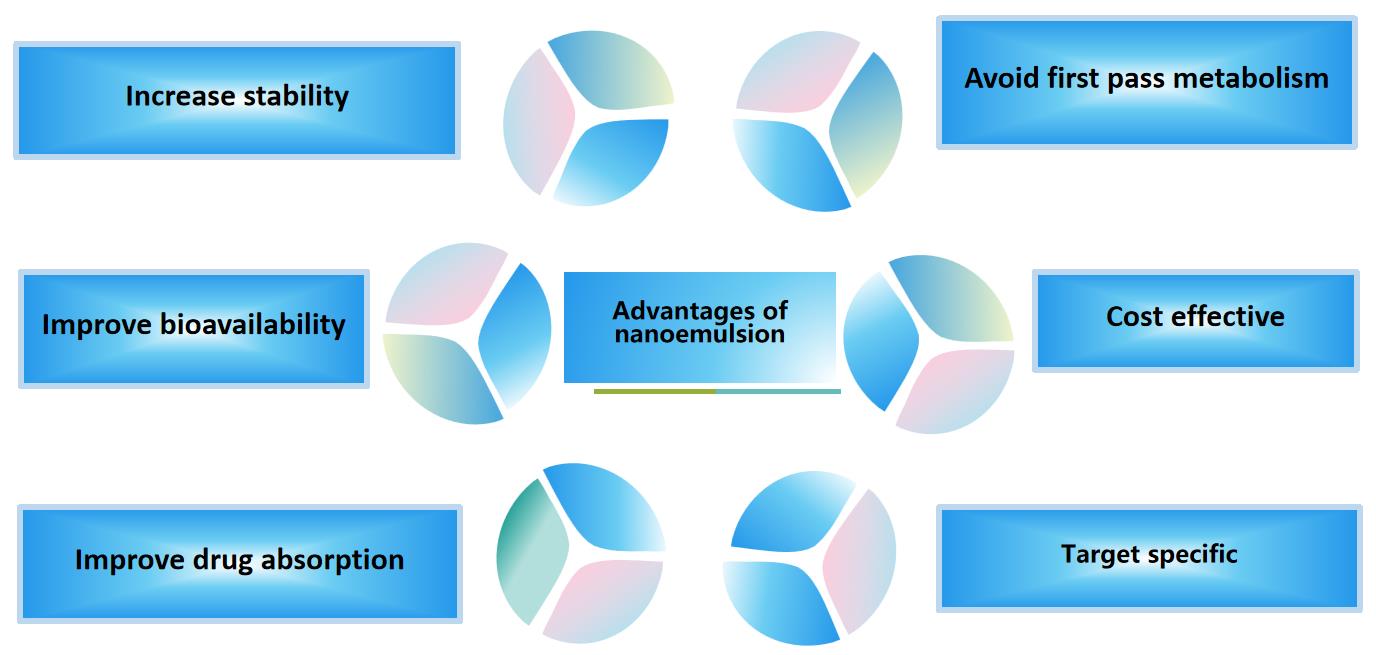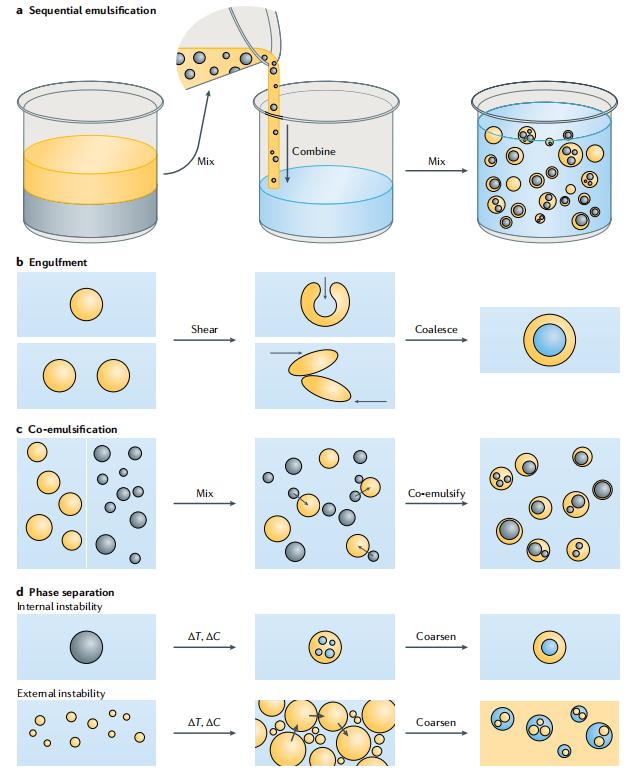Nanoemulsion Development for Nanomedicine
Inquiry
CD Formulation can provide our clients with nanoemulsion development services for nanomedicines to meet the different requirements using our advanced nanoemulsion preparation technology. Our highly qualified nanoformulation development team can design and configure nanoemulsions based on different preparation techniques, thus promoting research of nanoemulsions for nanomedicine.
Advantages of Nanoemulsion
Nanoemulsions are biphasic dispersions of two immiscible liquids, such as water-in-oil (W/O) or oil-in-water (O/W) droplets stabilized by amphiphilic surfactants, have small droplet sizes ranging from 10 to 1000 nm, and consist of solid spheres with amorphous and lipophilic surfaces. Nanoemulsions are excellent carriers for various bioactive compounds and offer enhanced performance compared to traditional emulsions, with excellent properties such as high optical clarity, physical stability, and enhanced bioavailability.
 Fig.1 Advantages of Nanoemulsion. (CD Formulation)
Fig.1 Advantages of Nanoemulsion. (CD Formulation)
Our Nanoemulsion Fabrication Methods
There are primarily two broad categories of techniques for the preparation of nanoemulsions: high energy methods and low energy methods. CD Formulation relies on our advanced design concept to use the following preparation methods for nanoemulsion, such as high energy methods (high pressure homogenization, microfluidization, piston pump homogenizer, and ultrasonication, etc.), and low energy methods (spontaneous emulsification method, phase inversion temperature method and phase inverse emulsification method).
High Energy Methods
High Pressure Homogenization: High pressure homogenization means that under high pressure, materials are subjected to strong shearing force and pressure to achieve crushing and emulsification effects.
Microfluidization: This is a unique mixing technology that simultaneously reduces particle size through friction, impact, hydraulic shear, impact, severe cavitation, and turbulence.
Piston Pump Homogenizer: The piston pump homogenizer used in this process produces nanoemulsions with extremely small particle sizes.
Ultrasonication method: Premixed emulsions of micron-sized droplets are stirred ultrasonically to produce nanoemulsions. This technology uses an ultrasonic generator called an ultrasonic probe to deliver energy.
Phacoemulsification Method: The phacoemulsification method uses an ultrasonic device to use the action of ultrasonic waves to pulverize and disperse the immiscible liquid in the system and form an emulsion with the surrounding liquid.
Low Energy Methods
Low energy emulsification method is a method of preparing nanoemulsions by utilizing the internal energy of the system. The low energy emulsification method includes spontaneous emulsification method, phase inversion temperature method and phase inverse emulsification method.
Spontaneous Emulsification Method: Firstly, we prepare a homogenous organic solution encompassing oil, a lipophilic emulsifier, a water-soluble cosolvent, and hydrophilic emulsifiers. And then prepare an o/w nanoemulsion used a continuous magnetic stirring process, and the aqueous phase is removed with a reduced evaporation pressure process.
Phase Inversion Temperature Method: Phase inversion temperature method is based on the change of the molecular geometric characteristics of non-ionic surfactants with changes in temperature. In a ternary system containing water-oil-surfactant, when the temperature of the system rises to the phase transition temperature, the spontaneous curvature of the surfactant is close to 0, and the surface tension is the lowest at this time, and then the system is instantly cooled to obtain a nanoemulsion with a smaller particle size.
Phase Inverse Emulsification Method: Phase inverse emulsification method is a method in which water is gradually added dropwise to a certain ratio of oil-surfactant solution at a constant temperature. As the water content increases, the surfactant undergoes phase inversion, eventually resulting in O/W nanoemulsion.
Furthermore, aside from the mentioned methods for creating nanoemulsions, we are dedicated to investigating innovative technologies to develop advanced preparation techniques for nanoemulsions in order to offer expert assistance to researchers.
Our Analytical Capabilities for Nanoemulsions
To characterize and assess the viability of the nanoemulsion formulation process can be determined by monitoring changes in visual appearance, color, odor, taste, density, pH, osmolarity measurements, phase behavior studies, emulsion droplet polarity, thermodynamic stability studies, and dispersibility study and identification test for nanoemulsion. We can provide you with the following characterization of nanoemulsions including:
- Particle Size
- Zeta Potential
- Droplet Size and Polydispersity (Intensity Based Size Distributions) Index
- Viscosity
- Entrapment Efficiency
- Tunable Rheology
- Stability
Why Choose Us to Develop Nanoemulsions?
- We have created an advanced nanoemulsion technology platform that allows active pharmaceutical ingredients to be stably wrapped in nanocarriers to form nanoemulsions, thus significantly increasing absorption efficiency and bioavailability.
- Our process for preparing nanoemulsion includes shear emulsification, high-pressure homogenization and rotation sterilization, and the quality is controllable throughout the process.
- We have accumulated rich R&D experience in nanoemulsion preparation, including nanoemulsion formulation screening, nanoemulsion formulation process design and development, nanoemulsion stability and quality control.
Published Data
Technology: The techniques used to generate multiple nanoemulsions (including sequential emulsification, engulfment, co-emulsification, and phase separation)
Journal: Nature Reviews Materials
IF: 83.5
Published: 2020
Results:
The authors review the techniques used to generate and characterize a variety of nanoemulsions, understand the theory of their formation and stability, and discuss current and future applications that may arise from their unique structure and chemical properties.
Here is the techniques used to generate multiple nanoemulsions as follows.
 Fig.2 Schematic illustration of the techniques used to generate multiple nanoemulsions. (Tanvi Sheth, et al. 2020)
Fig.2 Schematic illustration of the techniques used to generate multiple nanoemulsions. (Tanvi Sheth, et al. 2020)
CD Formulation has always been at the forefront of nanoemulsion development for many years. If you need a requirement about our services, please feel free to contact us by phone or email, our colleagues will reply to you within three working days.
References
- Tanvi Sheth, Serena Seshadri, Tamás Prileszky, et al. Multiple nanoemulsions. Nature Reviews Materials. 2020, 5, 214-228.
How It Works
STEP 2
We'll email you to provide your quote and confirm order details if applicable.
STEP 3
Execute the project with real-time communication, and deliver the final report promptly.
Related Services


 Fig.1 Advantages of Nanoemulsion. (CD Formulation)
Fig.1 Advantages of Nanoemulsion. (CD Formulation) Fig.2 Schematic illustration of the techniques used to generate multiple nanoemulsions. (Tanvi Sheth, et al. 2020)
Fig.2 Schematic illustration of the techniques used to generate multiple nanoemulsions. (Tanvi Sheth, et al. 2020)
